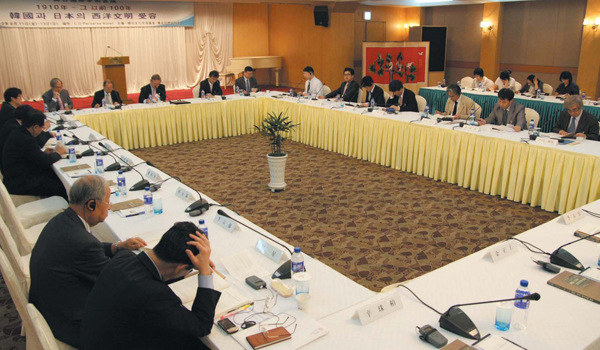동북아역사재단 2010년 07월호 뉴스레터
- Son, Seung-cheol Professor, Kangwon National University

A three-day academic conference co-hosted by the Korea-Japan Cultural Fund and the Northeast Asian History Foundation was launched on June 11.
East Asia experienced a massive influx of Western civilization in the 19th century. Japan undertook the Meiji Restoration and modernized early on. Korea, on the other hand, lagged behind in the wave of modernization and became Japan's victim. Japan's forced annexation of Korea in 1910 inflicted damage on both nations, and even today, it is a major impediment in the effort to bring about a peaceful regional order and Asian community.
It is against this backdrop that the conference undertook a comparative analysis of Korea and Japan in five areas—e.g., the perception of Western civilization, economic and political reform, and national education during the 100 years leading up to 1910. Five Japanese scholars and five Korean scholars presented a total of ten papers.
East Asia in the 19th century was when "burning charcoal and ice met," to borrow a common Korean expression of that time. That is, it was a period during which conflicting paradigms clashed. According to a noted Japanese thinker Fukuzawa Yukichi [福澤諭吉], "[The period] was like an encounter between burning fire and ice-cold water, a single body living two different lives, or one person in two different bodies."
The large majority of Joseon's politicians and intellectuals at the time only interpreted what was happening internationally as a "quantitative" increase of a new threat—i.e., western barbarians. That is, they saw it merely as a type of "phenomenal" change. Nevertheless, a new faction was slowly budding within the Joseon political circle. This faction showed an interest in the new paradigmatic shift in the world. Thereafter, starting in the 1880s, a movement for reform and opening began developing with the king at the center.
However, after the Gapsin Coup, conservatism returned with gusto and a fissure began to form within the locus of political power. This led to the Donghak Peasant Rebellion, which was a demand for reform from below, as well as the ruthless suppression of foreign intervention. Ultimately, foreign powers engaged in war, fighting over Joseon. This clearly demonstrates how the different perceptions of the times among major political factions in 19th-century Joseon conflicted and clashed, leading to one political misstep after another.

Ideological conflicts and political missteps in Joseon during the transitional period
In modern East Asia, the word "empire" meant something very different from how it is used today—i.e., a state exercising military, economic, and political power beyond its domain as an independent, sovereign state. At that time, both Korea and Japan used "empire" to simply mean an independent, sovereign state. Therefore, in modern Asia, the "empire" in Emperor Meiji's Empire of Japan or Emperor Gojong's Greater Korean Empire denoted an independent state.
In this sense, the following idea was very novel: both Joseon and Japan attempted to confront the West based on an objective and accurate perception of the world, respectively transcending Japan-centrism and the Wijeongcheoksa [literally, defend orthodoxy, reject heterodoxy] ideology. It was claimed that the countries were equals, but this claim was criticized as being far removed from reality. Another interesting argument was that Japan eventually invaded Joseon because Japan's objective was rising to be on par with great powers, and yet ideologically, Japan still tried to maintain its superiority.
Looking back at the 100 years preceding 1910 for the 100 years to follow
One of the major issues of debate was how we should regard the relationship between state-led education and private education in the modernization process. Fundamentally, the dynamics between public education and private education should be regarded as competitive yet complementary. There were similarities and differences between education led by the Governor-General and private education. The common ground was that both were resisted by Koreans who had received traditional education and held traditional views.
College education—i.e., higher education—was necessary for the simultaneous realization of modernization and independence. However, while college education was a necessary condition, it was not sufficient. A case in point is Japan. Japan's education is linked to Japan's continental aggression. It was thus pointed out that modern education had erred concerning the changes in the global landscape.
Many other issues resulted in heated discussions. This international academic conference was noteworthy because it undertook a comparative study of Korea and Japan during the 100 years leading up to 1910, while all other recent academic conferences focused on 1910 and Japan's forced annexation of Korea.
The conference was meaningful in that we compared how modern Korea and Japan perceived and accommodated Western civilization. We also examined how each nation tried to shape its history and culture based on its perception and adoption of the West as well as how this effort actually panned out in reality. By reflecting on the history of Korea and Japan 100 years ago, the conference has contributed to the effort to bring about 100 years of harmonious coexistence and mutual advancement.


